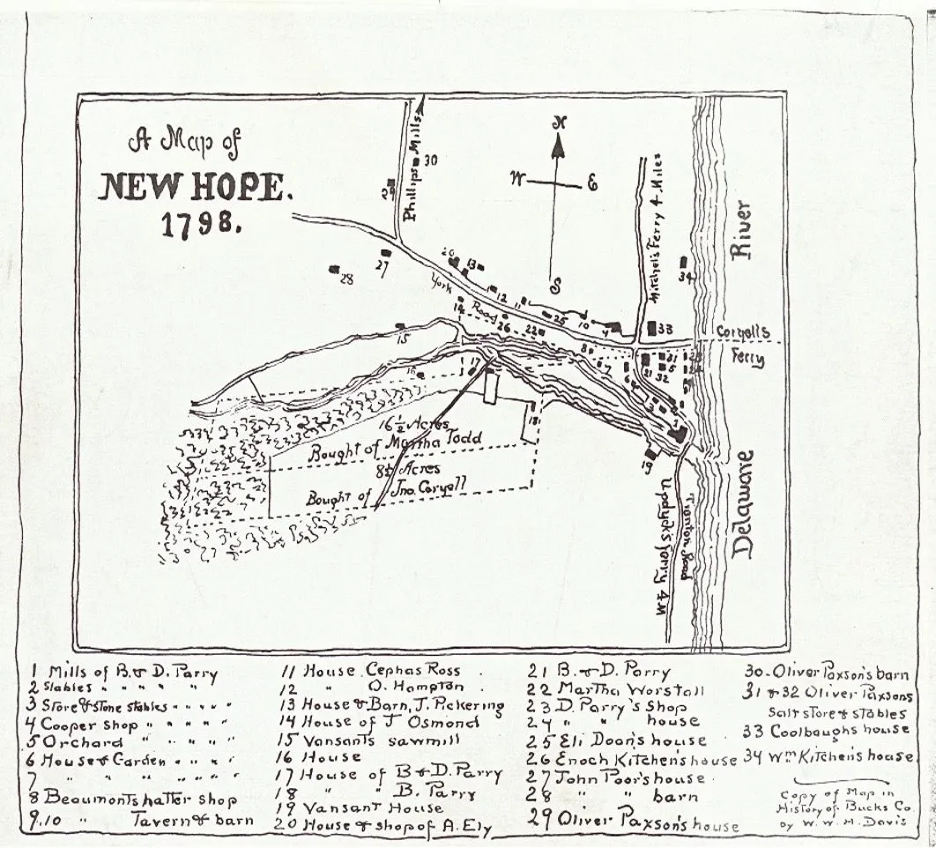A ferry town on a strategic road (early–late 1700s)
The settlement that became New Hope sat on the Old York Road, the principal overland route linking Philadelphia and New York. By the 18th century it was widely regarded as the halfway stop, where travelers lodged before being ferried across the Delaware River at daybreak.
Regular river passage began in the early 1700s. John Wells opened a ferry in 1722; later the business passed to the Coryell family, and the riverside hamlet took the name “Coryell’s Ferry.” The ferry’s prominence—and the road it served—anchored a small service economy of taverns, smiths, and stores along the riverbank.
Parry brothers create a lasting legacy (late 1700s-early 1800s)
Benjamin Parry acquires the famous new Hope Mill along with other properties in 1789 from Dr. Joseph Todd, of Todd family of settlers of William Penn’s Pennsylvania settlement. After Dr. Todd’s passing, the mill was inherited by his wife, Martha Todd, and his sons Charles and William Todd.
“Benjamin was born on his grandfather's estate; and as a boy spent summers working in Dr. Joseph Todd's grist mill at Coryell's Ferry. An owner in absentia, Dr. Todd was a neighboring landholder in Horsham; and one could safely assume that Benjamin and his six brothers spent their summers in honest labor. The family’s business was lumbering. Founded by his grandfather Thomas, the assets grew to include vast timberlands in northeastern Pennsylvania, sawmills along the Delaware River and lumber yards in Philadelphia.”
-National Register for Historic Places Application by New Hope, 1985
Along with the mill, Benjamin Parry purchased further Todd family holdings, including the larger tract that contains the John Quigley House site. A map created by Benjamin Parry of New Hope shows the original boundary of the property, labeled “16 ½ Acres Bought of Martha Todd”

Industry needs its mechanics
Mechanic Street took its name from the tradespeople who built and serviced New Hope’s industries: in the early republic a “mechanic” was a skilled artisan—carpenter, millwright, smith—rather than a machine repairer. The land that includes the present 95 West Mechanic lay within the tract the Parry family held from 1789.
The street itself likely existed as a footway long before it was designated an actual street. The two cluster of buildings to down the road to the east and up the road to the west likely were tied to workers of the Maris mills, an eccentric industrialist. The John Quigley House is curiously carved out of the larger Parry property before being sold to its first documented occupant in 1842, Joseph Horn.
The Horns were under regular employment by the Parrys as carpenters, which may give an understanding of how the ultimately ended up with a special, and only, detached slice of this Parry property.
Courtesy of the Mercer Museum research library, we see the history of the Horn family employment by the Parrys
The records of the time become contradictory. Tax records show the Horns with a “House + Lot” well before being sold the lot. It can be assumed that the Parrys built worker housing on their land, and later carved it out to sell to a trusted family in their employment.
-Early plan for the property found in the late Benjamin Parry’s papers, housed in the Mercer Museum Research Library
